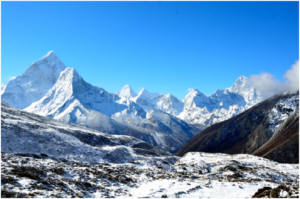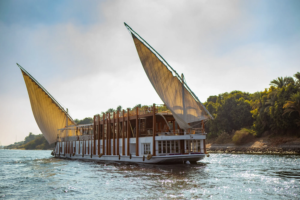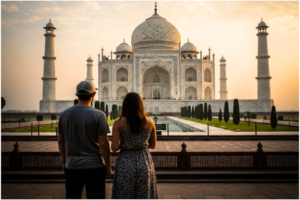The Magic Of The Himalayas: My Journey To Everest Base Camp With Sherpas

Magic lingers in the Himalayas, in a world as otherworldly as it is vast — a place where the sky holds the earth in its rough, untamed beauty. My journey to the base of Everest was more than a walk; it was truly a sojourn to the soul, a pilgrimage into the very heart of nature and culture. Towering Himalayan peaks inspired awesomeness and humility, even as I traveled an ancient path free, stone and devotion molded. Each step was leading me not only to the base of the iconic Everest but also to the deeper realms of life, resilience, and connection.
Everest Base Camp Trek With the Sherpas – the legendary keepers of these mountains – I became connected to the land and its inhabitants from the very onset. In their wisdom, humility, and strength, they led us into a country that stretched our limbs out and woke up our souls. The crunch of boots in a steady rhythm on gravel, prayer flags flapping in the mountain musk, and faint jangling of yak bells were the soundscape of our adventure. The thin, thin air took out of every breath a little piece of you, but that combat carried with it an extraordinary clarity; a presence.
We drove through tiny, isolated villages, surrounded by snow-capped giants, where I saw a life lived so entwined with nature. They were all about shared stories, stories which had been handed down from generation to generation, and that, as Sridhar said, brought to life the rocks and rivers and trails. Their cackles carried between the hills and amongst themselves, a lesson that people take joy in.
For me, getting to Everest Base Camp was one big haze of disbelief. Rimmed with icy waterfalls and jagged ridges, I paused in solemn awe. It was not about defeating a destination but rather about the journey to get there. I felt incredibly small and impossibly alive. The Himalayas, in all their silent majesty, had been about more than simply a physical test; they had given me a look at the strength of the human spirit, the power of nature, and the quiet magic of what happens when we walk with intention and an open heart. This trip with the Sherpas will be engraved in my heart as a magical journey towards wonder, respect, and gratitude.
Up to Day Hike with Introduction to Himalayan Dream
The mythical pull of the Himalayas has lured explorers, mystics, and dreamers for centuries. — EarthTouch, “These mountaintops are truly Asgard.” These mountains, soaring above the clouds, are more than just a geographical wonder — they’re a symbol of spiritual awakening, raw natural beauty, and human endurance. For most of us, to enter the Himalayas is not just a trek through perilous landscapes, but it’s also a pilgrimage to the heart of nature and the soul. The stuff of a dream. Since it is hardly known to anyone outside its more formal borders, the dream of trekking in this most iconic region begins with stories of soaring mountain peaks, secluded monasteries, and the fabled Mount Everest.
From conception to birth, the Himalayan dream is fed on imagination. It conjures images of vibrant prayer flags blowing in the wind, yaks trudging along narrow mountain paths, and starlit skies above hushed valleys. Whether it’s the siren call of Everest Base Camp or just pure, uninterrupted bliss on a less-travelled path, every step in the Himalayas will change you in profound ways.
And it is not the exclusive dream of elite mountaineers — Everest Base Camp Treks the world over, average adventurers pursue it. It’s not just about the summits; it’s about the journey, the culture, the challenge, and the people.” Long before boots echo off a trail and lungs suck thin mountain air, the dream begins in the heart. And once it begins, it never really ends.
Preparing for the Adventure
You don’t enter trekking in the Himalayas lightly; it requires physical stamina, mental strength, and serious tactics. TREKKING Even before they join the starting point, the trekker has to go through the training of weeks or even months. Strengthening your cardiovascular system with cardio, strength, and long hikes to tackle the steep ascents and high altitudes.
But it’s not only about fitness. Gear selection is crucial. From hardwearing hiking boots and insulated jackets to durable backpacks and walking poles, everything is designed to make the hike safe and comfortable. Layering is crucial, as temperatures can fluctuate dramatically over the day and across varying elevations. Traveling light, yet fully equipped, is a science that trekking veterans swear by.
Just as vital is knowledge of altitude sickness. It’s important to know when you should treat or prevent acute mountain sickness (AMS). Acclimatization is something many trekkers research and discuss with travel doctors for medicine like Diamox and vaccinations.
There’s a lot to be said for mental preparation, which many people underestimate. It makes all the difference to be prepared for the unpredictable weather, late flights, and the physical strain of the trek. Learning about the culture and traditions of the area also adds ‘touches’ and is respectful of the local people.
With planning, what originally seemed to be an unattainable dream becomes a possible reality. And the closer the departure day gets, the more excited you are, because you know that the trip of a lifetime is just days away.
The First View of the Mountains
There’s a singular thrill to catching that first real glimpse of the Himalayas. For most trekkers, it comes while exiting the plane from Kathmandu to Lukla — a small aircraft flying over valleys and in the distance, jagged white mountains that rise in sharp peaks to cerulean heavens. It’s the sort of moment that takes your breath away, not just because of the altitude, but because the dream has suddenly become real.
Fearing the worst, I step off the plane and look around, and it’s all one can do not to be impressed. The landscape is dotted with towering ridgelines, the air is cleaner and crisper, and the wail of the city is traded for the rustling of the wind and the hum of yak bells in the distance. Even for experienced hikers, it is the first sight of the Himalayas that they never forget.”
Villages, tucked into the folds of precipitous hillsides, feel like they could belong to another century. Serene and spiritual, the region is populated by stone houses, prayer wheels that turn slowly, and colorful prayer flags that snap in the wind from the rooftops. Its people are friendly and warm, and proud of their history. Things are slower, more meaningful.
This initial vision colors how the rest of the trip will be. It is what the trekkers traveled for, reminding them just why they came and the point of every mile to come. The Himalayas may be photographed and filmed for eternity, but nothing matches the experience of laying your eyes on them. The scale, the silence, the grandeur — it can humble you in an instant.
And suddenly, the mountains are no longer a figment of the imagination. They’re right there, inviting you to walk with them.
Meeting the Sherpas: Guardians of the Himalayas
Mount Everest base camp Trek. You can’t travel to the Himalayas without encountering the Sherpas—mythical high-altitude people with a reputation for enduring in the most hellacious of conditions and for their deeply spiritual connection to the land. For generations, Sherpas have made their homes in the high, mountainous regions of Nepal, with the epicenter being the Khumbu Valley, and have become a byword for Himalayan expeditions.
From the outside, Sherpas are sometimes perceived merely as guides or porters. But in fact, they are much more. They are the mountains’ soul. They have unbeatable local knowledge of the terrain, the weather, and mountain culture. A lot are multilingual, with an amazing sense of direction, and have taken numerous climbers safely through dangerous routes.
To meet a Sherpa is to encounter a living fragment of Himalayan history. They are stories of courage — of summiting Everest, of surviving avalanches, and of saving climbers in impossible conditions. But they do so with modesty, some smiling cheerfully and others simply acknowledging in a soft nod the ease with which they are lugging back-breaking loads twice their size up steep slopes.
They are also profoundly spiritual, following Tibetan Buddhism, and their culture is rife with rituals that pay respect to the mountains. Among the Sherpa, it is customary for a pujari, or shaman, to conduct a “puja” ceremony, in which the mountain gods are entreated for dear life before a trek or climb.
While you walk with these characters, you also come to realize how broadly they shape the trekking experience, beyond logistics and into feelings. It’s not just their strengths that they inspire in those trekkers, but their kindness, their wisdom, and their calm in the face of nature’s cruelty. The Sherpas are indeed the keepers of the Himalayas.
The Journey Begins: Lukla to Phakding
The adventure itself starts at Lukla (2,860 meters), a mountain town that is home to one of the most exhilarating airstrips on the planet. You can feel the slowdown as soon as you get off the plane. Life is pared down here: to nature’s natural rhythm, and the mountains that serve as a backdrop in every direction. This is the point at which the rubber meets the road – literally.
The route from Lukla to Phakding provides a relatively benign taster for Himalayan trekking. It’s 6-8 km, should take you 3-4 hours. The trail weaves through pine forests, crosses high suspension bridges made of metal, swinging above steep gorges over rivers and through villages with stone houses and teahouses strung with prayer flags.
The Dudh Koshi River, glacial melt the color of milk, rushes by the trail, an ever-present friend in the early going. Trekkers generally pause at mani walls and spinning prayer wheels, soaking in the physical and spiritual landscape.
Everest Base Camp Most people spend their first night in Phakding, at about 2,610 meters. Nestled in a peaceful valley, the village has cozy teahouses where trekkers can find hot meals and rest before heading out on steadier, more strenuous climbs. Even on what will be one of the more manageable days, you can feel the elevation and the energy in every step.
Stars cover the sky with an absolute purity when the night comes. It’s an otherworldly start — humble and potent. The body is adapting, the heart is pounding, and the road to Everest has well and truly started.
Climbing Higher: Namche Bazaar and Acclimatization
From Phakding, the trail ascends, passing through forests and across spectacular suspension bridges (the most spectacular being the Hillary Bridge) as it hugs the banks of the Dudh Koshi River. Today is described as one of the tougher early stages as you ascend to the heart of the Khumbu region, Namche Bazaar.
Namche is at an elevation of 3,440 m and is an important acclimatization point for all trekkers en route to Everest Base Camp. The climb to Namche is the final ascent, and it is steep and tiring, often proving a challenge even to the most fit hiker. But when you round the final bend and the village reveals itself in all its colorful, terraced wonder built right into the mountainside, it’s worth it.
Namche Bazaar is an animated market town and offers many goods in the markets, bakeries, internet cafes, and even a small museum on Sherpa culture and Everest history. It’s the last big town before higher elevations, the ideal spot to relax, regroup, and get used to the thinner air.
Acclimatization is not just rest; it’s active accommodation. What trekkers do instead is go on a short trek to the surrounding viewpoints, such as the Everest View Hotel or the Khumjung Monastery. Such mini treks allow the body to adjust and also have stunning views of Everest, Lhotse, and Ama Dablam.
It is important to spend at least two nights in Namche. It’s an opportunity to ease off, enjoy the ride, and prime the body for greater challenges to come. Namche Bazaar is a favorite stop for many on the trail, with its charm, history, and dazzling vistas.
Into the Heart of the Khumbu Region
Himalayan Base Camp Trek Khumbu has an exciting first entry — a flight to Lukla, considered one of the scariest airports on the planet! The path will then meander through ancient Sherpa villages, rhododendron forests, and thundering rivers, each day dragging you further into a world that time forgot. The Khumbu, you see, is no mere destination; it’s more like a living patchwork of culture, nature, and history. As I walked village to village — from places like Phakding to Namche Bazaar — the locals there welcomed me with warm smiles and a spray of rainbow prayer flags, and the lightness and the gratitude of the snow-draped peaks were never far from view. In this place, people live in tune with the rhythm of the mountains, bringing up their followers from tradition, and a resilient hope. The Khumbu is where the trek to Everest starts, not just physically, but in spirit and soul. A place where the modern world falls away and all that’s left is the silence of the highlands and the whisper of ancient winds. Every village, every stupa, and every carved stone mantra carries a story that touches your soul. The more I explored, the more I discovered the Khumbu as not just a region but a community, a beating heart that all who passed through would be bound together by in a shared sense of wonder, gratitude, and purpose. Here was where the magic of the Himalayas first really gripped me, and it was the start of an incredible journey.
Magical Moments in Tengboche Monastery
Tengboche Monastery, set on a ridge with panoramic views of Ama Dablam and Everest, was a kind of gateway to the divine. As I walked to its red-gated entrance, prayer wheels turned softly in the wind, and incense competed with the scent of pine. Timepyou slowed as soon as I walked in. The soft murmur of the monks’ chanting against a backdrop of jagged peaks evokes a profound sense of peaceful introspection. But there was something more than religious belief at this monastery, the spiritual heart of the Khumbu valley; there was a quiet, calming spirit that seemed to infuse every traveler in it. I sat cross-legged alongside trekkers and monks during a prayer ceremony in a moment of shared stillness and unity that humbled me. To see the monks (many of them children, really) chanting ancient sutras was to be filled with both awe and wonder. I felt, in that soul-cleansing hour spent in the company of ancient thangkas and the flicker of butter lamps, so very connected to the land and its people. It’s a reminder to me that the Everest Base Camp trek is not just a test of physical endurance — it’s also a test of spiritual morale. At Tengboche, the trail took a breather — a holy exhalation — and allowed me to listen to the mountains, to the silence, and myself. It wasn’t just a visit — it was a moment of sharing, gratitude, and transformation that I’ll never forget.
Surviving the Altitude: Hard Times on the Trail
Arguably, one of the biggest factors of the Everest Base Camp trek is the relentless battle against increasing altitude. At higher than 3,000 meters, every breath is an orchestration of will. I soon realized that this wasn’t just a physical climb — it was a mental one as well. The altitude made itself felt in every respect of the journey. Even basic activities like walking, eating, and sleeping were now more challenging. The headaches, the lethargy, the breathlessness — all were constant reminders of the mountains’ ability to humble you. Unpredictable blessings and patience lessons were the acclimatization days. Climbing high during the day and sleeping low was a rhythm that both dictated our progress and allowed our bodies to acclimate at a slower pace to the thinning air. I came across some fellow trekkers along the way who were struggling and others who turned back — it was a powerful reminder that this trek commands respect, preparation, and a strong mindset. The Sherpas were like balm during those moments, giving encouragement, tea, and talking with stories that lightened our hearts. And, though uncomfortable, there was something strangely gratifying in making it through. Every high pass, every steep climb was a triumph — not just over altitude, but over self-doubt. These difficulties whittled a core of quiet strength I’d never known. The trail was hard on my body but great for my soul, and it was a good reminder that sometimes the craziest paths take us to the most worthwhile places.
Reaching Everest Base Camp
Everest Base camps Reaching Everest Base Camp was like walking into a dream — breathtaking and desolate. Amid icefalls, glacial boulders, and the towering Khumbu Icefall, I was on my knees, because suddenly I was struck dumb with the enormity of the moment. The fluttering prayer flags in the Rothang winds, the trekker boot imprints on the frozen path, and the trekkers hugging each other brought it all to life. Following days of trekking over rough terrain, fighting the altitude, and hiking through pain barriers, the arrival in base camp was a combination of soul and endurance. You can’t see a summit from here, but there’s electricity in the air — the feeling of being where tens of thousands of climbers set off to climb to the top of the world. The camp itself is a modest litter of tents on a frosted world, but the feeling that it invokes is enormous. I was stuck there for ages, just standing and soaking up the silence and the sanctity of this room. This wasn’t the end of the trek; it was the total of what I had felt along the way — the connection to nature, to the Sherpa culture, to the people with whom I had walked persistently together. Everest Base Camp isn’t just a place; it’s a point in time, one that now shines in my memory with the silent pride of achievement, not so that others may know, but so that I will never forget.
Reflections From the Top of the World
Standing so near to the base of the tallest mountain on Earth inspired a cascade of thoughts about life, ambition, and the allure of simplicity. Here above, where the sky is closer and the world’s noise goes quiet, I found a clarity difficult to experience in the day-to-day. The Himalayas have a talent for cutting to the chase. There’s no place for ego or distractions, just the elements and your mind. I thought about the characters I met on the trail, the quiet bravery of the Sherpas, the solidarity between trekkers, and the little moments that linger. The effort of the climb made the deadness up here seem justifiable. There was something profoundly humbling about being in a place so big, so unspoiled, that it didn’t care who you were, just that you respected it. I had a new sense of equilibrium, a rootedness that I hadn’t even realized I had been searching for. As the sun went down over the peaks and long shadows spread onto the glacier, I grasped that it was the experience that had changed me. Getting to Everest was not purely about getting to Everest — it was about getting to a place inside myself I had forgotten existed. This, quiet and strong, is the true gift of being on top of the world.
So long: Wisdom from the Himalayas
Everest Base Camp trek cost It was bitter leaving the Himalayas. ‘I’m going down those same twisty trails, but now everything looks waaaaay different — familiar! Still, the mountains had schooled me in ways I never would have anticipated. They showed me patience, humility, and the power of vulnerability. I came to believe that sometimes slowing down is not weakness but wisdom, and that silence can be corporal. The Sherpas and their unbreakable spirit and unwavering kindness made an impression on me that I knew would last a lifetime. Their way of life, based on community, respect for nature, and slow perseverance, seemed like a roadmap toward a more meaningful way to live. I took those lessons with me with each step, all the way down. Saying farewell wasn’t so much about departing a place, but carrying forth what the Himalayas had offered me. Once the peaks had retreated behind the clouds and the trail drew back into the hubbub of Lukla, I knew I would never see the world in quite the same way again. The odyssey had been done, the influence lingered with them — a compass pointing toward what mattered. The Himalayas ultimately offered me more than an adventure: They granted me a fresh sense of purpose and a story I’ll bear the rest of my life.
What is the summary of Everest: My Journey to the Top?
Everest: My Journey to the Top chronicles the experience of one man’s life in the remote, mysterious heart of the Himalaya as a trek through Everest Base Camp turns into a years-long story of hardship and adventure on some of the continent’s most challenging peaks. It is a story of physical trials, emotional crutches, and spiritual awakenings experienced on the journey. The trip starts through the colourful Khumbu, trekking through stunning and varied scenery and Sherpa villages. The book focuses on the strength and wisdom of the Sherpa people, the calm spirituality of locales like Tengboche Monastery, and the constant battle to acclimatize to high altitudes. This is also an account of the slow and tantalizing progress towards the mountain’s famous base at the foot of the world’s highest mountain, with imagery of glaciers, snow-capped peaks, and moments of stillness. Part adventure story and part inspirational memoir, Peaks guides the reader through the ups and downs of travel, while teaching that life is an adventure that must be survived: there is no easy way out. And so we don’t rally to the summit, but to an awesome experience of nature, culture, and self-realization. It is a salute to resilience, to humility, and to the fundamental humanity we share with the wild places that define us, and it’s also both an inspiring adventure and a meditation on the deeper meaning of life itself.
How much does it cost to trek to Everest Base Camp for Nepali people?
Everest Base Camp trek cost for Nepali nationals is considerably cheaper than that for foreign travelers. The price can fluctuate depending on how a trek is booked — independently or with a local company — but according to my guide, in general, a Nepali trekker may pay anywhere from NPR 25,000-60,000 (or USD 190-450). This includes basic transportation to and from the trailhead, lodging in tea houses, food, and any permits that are needed. As opposed to foreign trekkers, Nepali people don’t have to pay the expensive national park fees, and they don’t need a TIMS (Trekkers’ Information Management System) card, which makes trekking cheaper. Although if a trekker is from Nepal and decides to join a guided group, or rents porters for comfort, then the cost is increased in proportion to the facilities provided. That said, because of local know-how, even obtaining discounts, and being used to the environmental and linguistic territory, many Nepalese trekkers can do the journey very cheaply. Its low cost also lets more local adventurers and students visit the region, deepening their relationship with their country’s natural wonders. For Nepalis, the trek represents more than an enormous physical feat —it’s a spiritual and cultural experience, as they follow in the footsteps of their ancestors and the mountaineers who have gone before them.
What are the Sherpas of the Himalayas?
The Sherpas are a Nepalese ethnic group with highland ancestry. This community is distributed throughout the most mountainous regions of Nepal, the Himalayas, the fabled and angel-blessed land of Buddha, and the home of the world’s highest mountains. Benjamin43 / Getty Images People aren’t just impressed by Sherpas’ superhuman strength, stamina, and ability to climb mountains. But their sense of self is far more complex than their image as the Everest guides. Sherpas possess a rich culture that has been largely shaped by Tibetan Buddhism, having valuable traditions which emphasize the importance of community, respect for nature, and spirituality. They are defined by their hospitality, their ability to endure hardship, and their highly bonds of family loyalty. The Sherpas, who migrated to Nepal from Tibet more than 500 years ago, have a shared existence with the mountains in their background. Today, many Sherpas earn a living by working in tourism as guides, porters, and supporting expeditions, sometimes risking their lives to help climbers reach the summits of the highest mountains in the world. Due to their familiarity with the territory, acclimatisation to high altitudes, and their tenacity and determination, they have since become an integral part of all Himalayan expeditions. Crucially, however, Sherpas have battled to be better recognized, better paid, and for better safety standards. They not only form the backbone of Himalayan climbing but are also guardians of the sacred peaks. Their legacy is more than what they achieved physically — it’s in the wisdom of sacrifice and in the calm strength that inhabits life in one of the harshest places on Earth.
How much does a sherpa get paid to climb Everest?
Trek To Base Camp Mount Everest. The Sherpas who “fix” lines for climbers trying to summit Everest earn different pay depending on their role, experience, and the guiding company they work for. A high-altitude climbing Sherpa makes on average 3000–6000 USD in a single Everest climbing season that extends for two months. For Nepal, that little bit of monthly income is substantial, as the average annual income there is much lower than in the US. Yet the readers they take on are massive. Sherpas carry heavy loads, navigate treacherous icefalls, fix ropes, establish camps, and often make multiple runs through dangerous sections such as the Khumbu Icefall to ensure the safety and success of the expedition. But in addition to salaries, many Sherpas can earn tips and bonuses from climbers who appreciate the service, particularly if the climbers reach the summit. A few veteran Sherpas, especially those with a good track record of successful ascents, can make more, or partner with top international expeditions that pay more and use better gear. Yet, for many, the pay isn’t enough, especially in light of the life-threatening risk they face. There has been a rash of conversations and activism about raising Sherpa wages, providing better life insurance, and such. The money may be significant, but for many Sherpas, climbing Everest is a matter of pride and tradition, a living handed down to them over generations at the foot of the world’s highest mountains.





